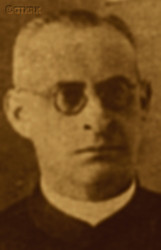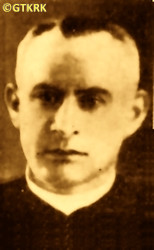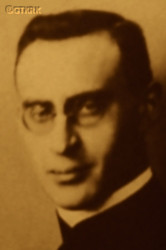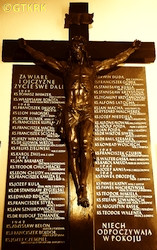Roman Catholic
St Sigismund parish
05-507 Słomczyn
85 Wiślana Str.
Konstancin deanery
Warsaw archdiocese, Poland
full list:
displayClick to display full list

searchClick to search full list by categories
wyświetlKliknij by wyświetlić pełną listę po polsku

szukajKliknij by przeszukać listę wg kategorii po polsku

Martyrology of the clergy — Poland
XX century (1914 – 1989)
personal data
surname
KUPILAS
forename(s)
Francis (pl. Franciszek)
function
diocesan priest
creed
Latin (Roman Catholic) Church RCmore on
en.wikipedia.org
[access: 2014.09.21]
diocese / province
Katowice diocesemore on
en.wikipedia.org
[access: 2013.05.19]
Wrocław diocesemore on
en.wikipedia.org
[access: 2013.05.19]
RC Military Ordinariate of Polandmore on
en.wikipedia.org
[access: 2014.12.20]
honorary titles
„Polonia Restituta” Cross — 4th Class, Officer'smore on
en.wikipedia.org
[access: 2019.04.16]
(27.11.1929)
Gold „Cross of Merit”more on
en.wikipedia.org
[access: 2019.04.16]
(04.05.1929)
„Star of Upper Silesia” badge
Cross on the Silesian Ribbon of Valor and Merit — 1st Class
Silesian Ribbon of Valor and Merit
date and place
of death
29.10.1940

KL Buchenwaldconcentration camp
today: n. Weimar, Weimar urban dist., Thuringia state, Germany
more on
en.wikipedia.org
[access: 2022.01.09]
details of death
In 1919‐1921, after Poland regained independence in 11.1918, during preparations for a plebiscite that was to decide national destiny of Upper Silesia and Opole region supported his Polish cause.
After the plebiscite on 20.03.1921, during 3rd Silesian Uprising in 1921, chaplain to the Polish Lędzin Insurgents' Company, part of insurgents' 6th Pszczyna Infantry Regiment.
After German invasion of Poland on 01.09.1939 (Russians invaded Poland 17 days later) and start of the World War II, arrested by the Germans on 04.09.1939, a day after start of German occupation.
Jailed in Stary Bieruń and next in Rawicz prison.
From there on 16.10.1939 transported to KL Buchenwald concentration camp where slaved in quarries and where was murdered.
prisoner camp's numbers
4287/10173Click to display source page (KL BuchenwaldClick to display the description)
cause of death
murder
perpetrators
Germans
sites and events
KL BuchenwaldClick to display the description, RawiczClick to display the description, «Intelligenzaktion»Click to display the description, Ribbentrop‐MolotovClick to display the description, Pius XI's encyclicalsClick to display the description, Silesian UprisingsClick to display the description
date and place
of birth
29.01.1882

Popielowska Koloniaform.: Klink
today: Popielów gm., Opole pov., Opole voiv., Poland
more on
en.wikipedia.org
[access: 2022.01.28]
parents
KUPILAS John
🞲 ?, ? — 🕆 ?, ?

KANIA Julianna
🞲 ?, ? — 🕆 ?, ?
presbyter (holy orders)
ordination
22.06.1912

Wrocławtoday: Wrocław city pov., Lower Silesia voiv., Poland
more on
en.wikipedia.org
[access: 2021.04.02]
positions held
1921 – 1939
parish priest — Lędzinytoday: Lędziny urban gm., Bieruń‐Lędziny pov., Silesia voiv., Poland
more on
en.wikipedia.org
[access: 2022.01.28] ⋄ St Clement, the Pope and Martyr RC parish ⋄ Mysłowicetoday: Mysłowice city pov., Silesia voiv., Poland
more on
en.wikipedia.org
[access: 2021.04.02] RC deanery
1920 – 1921
administrator — Lędzinytoday: Lędziny urban gm., Bieruń‐Lędziny pov., Silesia voiv., Poland
more on
en.wikipedia.org
[access: 2022.01.28] ⋄ St Clement, the Pope and Martyr RC parish ⋄ Mysłowicetoday: Mysłowice city pov., Silesia voiv., Poland
more on
en.wikipedia.org
[access: 2021.04.02] RC deanery
1918 – 1920
vicar — Lędzinytoday: Lędziny urban gm., Bieruń‐Lędziny pov., Silesia voiv., Poland
more on
en.wikipedia.org
[access: 2022.01.28] ⋄ St Clement, the Pope and Martyr RC parish ⋄ Mikołówtoday: Mikołów urban gm., Mikołów pov., Silesia voiv., Poland
more on
en.wikipedia.org
[access: 2021.12.18] RC deanery
1916 – 1918
vicar — Zgodatoday: district of Świętochłowice, Świętochłowice city pov., Silesia voiv., Poland
more on
en.wikipedia.org
[access: 2022.08.05] ⋄ St Joseph RC parish ⋄ Bytomtoday: Bytom city pov., Silesia voiv., Poland
more on
en.wikipedia.org
[access: 2021.04.02] RC deanery
1912 – 1916
vicar — Radzionkówtoday: Radzionków urban gm., Tarnowskie Góry pov., Silesia voiv., Poland
more on
en.wikipedia.org
[access: 2021.08.12] ⋄ St Adalbert the Bishop and Martyr RC parish ⋄ Tarnowskie Górytoday: Tarnowskie Góry pov., Silesia voiv., Poland
more on
en.wikipedia.org
[access: 2022.01.28] RC deanery
1912
priest — Popielówtoday: district in Rybnik, Rybnik city pov., Silesia voiv., Poland
more on
en.wikipedia.org
[access: 2021.08.12] ⋄ St Anne RC church ⋄ Jankowicealso: Jankowice Rybnickie
today: Świerklany gm., Rybnik pov., Silesia voiv., Poland
more on
en.wikipedia.org
[access: 2022.02.15], Corpus Christi RC parish ⋄ Żorytoday: Żory city pov., Silesia voiv., Poland
more on
en.wikipedia.org
[access: 2020.11.27] RC deanery — acting („ad interim”)
1908 – 1912
student — Wrocławtoday: Wrocław city pov., Lower Silesia voiv., Poland
more on
en.wikipedia.org
[access: 2021.04.02] ⋄ philosophy and theology, Department of Catholic Theology, University of Wrocław [i.e. University of Wrocław (since 1945) / Frederic Wilhelm University of Silesia (1911‐1945) / Royal University i.e. Breslau Academy (1816‐1911)]
others related
in death
BUKOWSKIClick to display biography Leopold, DOMERACKIClick to display biography Joseph Valentine, DRWALClick to display biography Francis, DRWĘSKIClick to display biography Stanislav Felix (Bro. Felician), GLAKOWSKIClick to display biography Stanislav, HANKEClick to display biography Francis, HAROŃSKIClick to display biography Leo Joseph, HUWERClick to display biography Joseph, KULISZClick to display biography Charles, LANGNERClick to display biography Herbert, PANKOWSKIClick to display biography Marian, POLEDNIAClick to display biography Paul, ROGACZEWSKIClick to display biography Adalbert Theophilus, SCHULZClick to display biography Joseph Valentine, SEKRECKIClick to display biography Henry, STOCKClick to display biography Joseph
sites and events
descriptions
KL Buchenwald: In German Germ. Konzentrationslager (Eng. concentration camp) KL Buchenwald concentration camp, founded in 1937 and operational till 1945, Germans held c. 238,380 prisoners and murdered approx. 56,000 of them, among them thousands of Poles. Prisoners were victims of pseudo‐scientific experiments, conducted among others by Behring‐Werke from Marburg and Robert Koch Institute from Berlin companies. They slaved for Gustloff in Weimar and Fritz‐Sauckel companies manufacturing armaments. To support Erla‐Maschinenwerk GmbH in Leipzig, Junkers in Schönebeck (airplanes) and Rautal in Wernigerode Germans organized special sub‐camps. In 1945 there were more than 100 such sub‐camps. Dora concentration camp was initially one of them, as well as KL Ravensbrück sub‐camps (from 08.1944). On 08.04.1945 Polish prisoner, Mr Guido Damazyn, used clandestinely constructed short wave transmitter to sent, together with a Russian prisoner, a short message begging for help. It was received and he got a reply: „KZ Bu. Hold out. Rushing to your aid. Staff of Third Army” (American). Three days later the camp was liberated. (more on: www.buchenwald.deClick to attempt to display webpage
[access: 2013.08.10], en.wikipedia.orgClick to attempt to display webpage
[access: 2013.08.10])
Rawicz: Prison, founded in 1819‐1821, in place of the Franciscan Friars Minor's monastery, which was liquidated by the Prussian occupation authorities. During the World War II, during the German occupation of 1939‐1945, the German Germ. Zuchthaus (Eng. heavy prison), intended for men sentenced to long‐term imprisonment and penal camp sentences, levied mainly by the Germ. Warthegau (Eng. Wartha region) occupation courts. A large part of the prisoners were next transported from there to German concentration camps. After the end of the military operations of World War II, the prison was managed by the Commie‐Nazi authorities of the Russian prl republic. Many activists of the Polish clandestine independence underground were detained there, including soldiers of the Home Army AK. Political prisoners were finally released in 1956. (more on: pl.wikipedia.orgClick to attempt to display webpage
[access: 2013.08.17])
«Intelligenzaktion»: German: «Intelligenzaktion» (English: „Intelligence Action”) — a German program of extermination of the Polish elite, mainly the intelligentsia and leadership layers, carried out from the beginning of the occupation in w 09.1939 to 04.1940, mainly in territories directly annexed to Germany, but also in the so‐called Germ. Generalgouvernement (Eng. General Governorate), where it was called «AB‐aktion». In the first phase, immediately after the beginning of the German occupation, during military operations carried out by the Germ. Wehrmacht (Eng. Armed Forces) and the genocidal units of the Germ. Einsatzgruppen (Eng. Operational Groups) of the Germ. Sicherheitspolizei (Eng. Security Police), i.e. SiPo, and Germ. Sicherheitsdienst des Reichsführers SS (Eng. Security Service of the Reichsführer SS), i.e. SD, organized by the Germ. Reichssicherheitshauptamt (Eng. Reich Main Security Office), i.e. RSHA, which followed the troops, carried out under the Germ. Unternehmen „Tannenberg” (Eng. Operation „Tannenberg”) — based on the so‐called Germ. Sonderfahndungsliste (Eng. Special Wanted Lists), i.e. proscription lists of Poles considered particularly dangerous to the Third Reich, prepared by the Zentralstelle II/P (Polen) unit of the German RSHA. Later, implemented by the German civilian occupation authorities and the genocidal unit of the Germ. Volksdeutscher Selbstschutz (Eng. Ethnic Germans Self‐Defense), whose members were Germ. Volksdeutsche (Eng. Ethnic Germans), i.e. representatives of the German minority in Poland. According to various sources, these lists, at the beginning of 09.1939, could have contained the details of 61,000—88,000 „dangerous” Poles — although these figures cannot be confirmed. In total, during this genocide, c. 50,000 teachers, Catholic priests, representatives of the landed gentry, freelancers, social and political activists, and retired military personnel were systematically and methodically murdered. Another 50,000 were sent to concentration camps, where only a negligible percentage survived. (more on: en.wikipedia.orgClick to attempt to display webpage
[access: 2014.10.04])
Ribbentrop‐Molotov: Genocidal Russian‐German alliance pact between Russian leader Joseph Stalin and German leader Adolf Hitler signed on 23.08.1939 in Moscow by respective foreign ministers, Mr. Vyacheslav Molotov for Russia and Joachim von Ribbentrop for Germany. The pact sanctioned and was the direct cause of joint Russian and German invasion of Poland and the outbreak of the World War II in 09.1939. In a political sense, the pact was an attempt to restore the status quo ante before 1914, with one exception, namely the „commercial” exchange of the so‐called „Kingdom of Poland”, which in 1914 was part of the Russian Empire, fore Eastern Galicia (today's western Ukraine), in 1914 belonging to the Austro‐Hungarian Empire. Galicia, including Lviv, was to be taken over by the Russians, the „Kingdom of Poland” — under the name of the General Governorate — Germany. The resultant „war was one of the greatest calamities and dramas of humanity in history, for two atheistic and anti‐Christian ideologies — national and international socialism — rejected God and His fifth Decalogue commandment: Thou shall not kill!” (Abp Stanislav Gądecki, 01.09.2019). The decisions taken — backed up by the betrayal of the formal allies of Poland, France and Germany, which on 12.09.1939, at a joint conference in Abbeville, decided not to provide aid to attacked Poland and not to take military action against Germany (a clear breach of treaty obligations with Poland) — were on 28.09.1939 slightly altered and made more precise when a treaty on „German‐Russian boundaries and friendship” was agreed by the same murderous signatories. One of its findings was establishment of spheres of influence in Central and Eastern Europe and in consequence IV partition of Poland. In one of its secret annexes agreed, that: „the Signatories will not tolerate on its respective territories any Polish propaganda that affects the territory of the other Side. On their respective territories they will suppress all such propaganda and inform each other of the measures taken to accomplish it”. The agreements resulted in a series of meeting between two genocidal organization representing both sides — German Gestapo and Russian NKVD when coordination of efforts to exterminate Polish intelligentsia and Polish leading classes (in Germany called «Intelligenzaktion», in Russia took the form of Katyń massacres) where discussed. Resulted in deaths of hundreds of thousands of Polish intelligentsia, including thousands of priests presented here, and tens of millions of ordinary people,. The results of this Russian‐German pact lasted till 1989 and are still in evidence even today. (more on: en.wikipedia.orgClick to attempt to display webpage
[access: 2015.09.30])
Pius XI's encyclicals: Facing the creation of two totalitarian systems in Europe, which seemed to compete with each other, though there were more similarities than contradictions between them, Pope Pius XI issued in 03.1937 (within 5 days) two encyclicals. In the „Mit brennender Sorge” (Eng. „With Burning Concern”) published on 14.03.1938, condemned the national socialism prevailing in Germany. The Pope wrote: „Whoever, following the old Germanic‐pre‐Christian beliefs, puts various impersonal fate in the place of a personal God, denies the wisdom of God and Providence […], whoever exalts earthly values: race or nation, or state, or state system, representatives of state power or other fundamental values of human society, […] and makes them the highest standard of all values, including religious ones, and idolizes them, this one […] is far from true faith in God and from a worldview corresponding to such faith”. On 19.03.1937, published „Divini Redemptoris” (Eng. „Divine Redeemer”), in which criticized Russian communism, dialectical materialism and the class struggle theory. The Pope wrote: „Communism deprives man of freedom, and therefore the spiritual basis of all life norms. It deprives the human person of all his dignity and any moral support with which he could resist the onslaught of blind passions […] This is the new gospel that Bolshevik and godless communism preaches as a message of salvation and redemption of humanity”… Pius XI demanded that the established human law be subjected to the natural law of God , recommended the implementation of the ideal of a Christian state and society, and called on Catholics to resist. Two years later, National Socialist Germany and Communist Russia came together and started World War II. (more on: www.vatican.vaClick to attempt to display webpage
[access: 2023.05.28], www.vatican.vaClick to attempt to display webpage
[access: 2023.05.28])
Silesian Uprisings: Three armed interventions of the Polish population against Germany in 1919‐1921 aiming at incorporation of Upper Silesia and Opole region into Poland, after the revival of the Polish state in 1918. Took place in the context of a plebiscite ordered on the basis of the international treaty of Versailles of 28.06.1919, ending the First World War, that was to decide national fate of the disputed lands. The 1st Uprising took place on 16‐24.08.1919 and broke out spontaneously in response to German terror and repression against the Polish population. Covered mainly Pszczyna and Rybnik counties and part of the main Upper Silesia industrial district. Suppressed by the Germans. 2nd Uprising took place on 19‐25.08.1920 in response to numerous acts of terror of the German side. Covered the entire area of the Upper Silesia industrial district and part of the Rybnik county. As a result Poles obtained better conditions for the campaign prior the plebiscite. The poll was conducted on 20.03.1921. The majority of the population — 59.6% — were in favor of Germany, but the results were influenced by the admission of voting from former inhabitants of Upper Silesia living outside Silesia. As a result the 3rd Uprising broke out, the largest such uprising of the Silesian in the 20th century. It lasted from 02.05.1921 to 05.07.1921. Spread over almost the entire area of Upper Silesia. Two large battles took place in the area of St. Anna Mountain and near Olza. As a result on 12.10.1921 the international plebiscite commission decided on a more favorable for Poland division of Upper Silesia. The territory granted to Poland was enlarged to about ⅓ of the disputed territory. Poland accounted for 50% of metallurgy and 76% of coal mines. (more on: en.wikipedia.orgClick to attempt to display webpage
[access: 2020.05.25])
sources
personal:
silesia.edu.plClick to attempt to display webpage
[access: 2024.12.13], www.ledziny.plClick to attempt to display webpage
[access: 2016.04.23], totenbuch.buchenwald.deClick to attempt to display webpage
[access: 2017.03.11]
original images:
encyklo.plClick to attempt to display webpage
[access: 2021.12.19], www.alamy.comClick to attempt to display webpage
[access: 2023.08.22]
LETTER to CUSTODIAN/ADMINISTRATOR
If you have an Email client on your communicator/computer — such as Mozilla Thunderbird, Windows Mail or Microsoft Outlook, described at WikipediaPatrz:
en.wikipedia.org, among others — try the link below, please:
LETTER to CUSTODIAN/ADMINISTRATORClick and try to call your own Email client
If however you do not run such a client or the above link is not active please send an email to the Custodian/Administrator using your account — in your customary email/correspondence engine — at the following address:

giving the following as the subject:
MARTYROLOGY: KUPILAS Francis
To return to the biography press below:
 Click to return to biography
Click to return to biography











